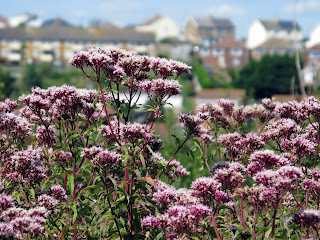The
woodsmen of the Sussex Weald walked out of the trees long ago now, taking their
coppicing tools and charcoal burners with them and leaving their woodland clearings to the relentless
green succession. This Wealden wood is a remnant of the great
Andredesweald forest of the South Saxons – Lindhersse to the Normans, who
gifted it to Battle Abbey and rechristened it The Abbot’s Wood. Banks and ditches and great marker trees
offer clues to the antiquity of the place. The
Forestry Commission is the current steward of the trees. Dark conifer
plantations have been felled and replanted with native broadleaved oak and
hornbeam interspersed with hazel, sallow and birch. Dormice and Pearl-bordered
Fritillaries are two species who benefit. We are visiting this twilight to find
another: the fern owl, goatsucker, dor-hawk of country folk; Caprimulgus
europaeus to science; the nightjar.
The sun has set; the full moon has
risen but cannot yet be seen above or through the encircling trees. A breezy
day has beclamed and the hazy sky softly glows in a palette of pastel shades.
With a growing sense of expectation, we step into the gloaming. There is
light enough to spot warblers and thrushes still feeding their nestlings. A
great-spotted woodpecker emerges from the trees. Moths rise earlier here; I
follow Agapeta hamana until it settles, Cochylis lacunana too.
We zig-zag our way along narrow woodland rides until a gap opens out into a
wide clear-felled area. Blackbirds, song thrushes, nightingales call across territories;
distant corvids pass; gulls make their easy glide coastbound. Low cloud is hugging
the downs and the weather there is less clement there than here. I give silent
thanks. We meditate to the thrushes’ poker song (I'll take your notes and
raise you something slightly more complex. Well I'll take yours and do the same).
From above and behind our right shoulders a large, silent silhouette glides
across us. Its long tapered wings, an underside speckled white and dark, the
unmistakably-shaped face. Our first nightjar – a female – appears and is gone almost
before we know it. The time is not much after nine. Low to the south the small
full moon is glowing through a wash of gossamer cloud.
In the distance the churring call of one or more nightjars waxes and wanes,
undulates, stops, begins again. It is almost a growl. The name: nightjar; I
cannot help but hear the woodsmen of old call the beast noightchurr as
they made their way home from the clearing, leaving the gloaming beasts to the
tightening murk. It is their time of day, not ours. No wonder it's the stuff of
myth, a beast that sucks the milk of goats. Sometimes it's too dark to tell
what the truth is.
The appeal of this bird skulks in
the twilight, the enigmatic hour of shifting shadows, wherein mysterious beasts
lurk. Winter is spent in Africa, south of the Sahara. A recent study found that
British nightjars migrate to and from the Congo. It is close to ten now and we
begin making our way home.
The path is a black ribbon. Dark clods plop around us in the murk, small
toads on closer inspection. Approaching home we are diverted by screeches
from a large oak which splays its branches above the path. They are tawny
owlets, two of them. Close by and louder, the churring resumes in a clearing behind the big oak. One, then two or more churrs pulsate through the air before
trailing off into silence, then a wing-clap, then the silhouettes of a first, second
and third nightjar swoop around us. It's a perfect coda.














